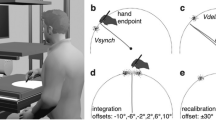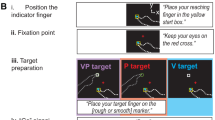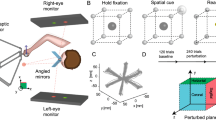Abstract
Conflicting theories of visuo-proprioceptive integration in movement control suggest that each modality can be weighted according to either its statistical reliability or the computations in which the integrated estimates will be used. However, the psychophysical experiments on which most studies are based use sensory conflicts and are therefore likely to reflect particular rather than normal behavior. In this paper, we: (1) propose a method avoiding the use of sensory conflicts (delayed recall task), (2) restrict our interest to spontaneous rather than adapted behavior, and (3) focus on a complex task requiring fine online control in order for hand movements to fit a precise path during execution. Subjects were provided with either visual, proprioceptive or both cues while their right hand was passively moved to fit a precise three segment pathway. As soon as this encoding phase ended, they were instructed to reproduce actively the trajectory, either with vision, proprioception or both cues. Results provide evidence that vision and proprioception may be used very differently, (1) not only according to the relative resolution of the sensory systems in the actual context, (2) not only according to the processes involved in the task, but also (3) according to subjects. They also suggest that visual and proprioceptive cues are not fused to provide a weighted average position, but that the non-dominant cue could simply be ignored when subjects are provided with multiple sensory cues. We conclude that each of these observations illustrates the same fundamental property of flexibility of integrative mechanisms.








Similar content being viewed by others
Notes
The results could be expected to reflect the effects of the modality in which a trajectory is memorized. However, since recall was performed as soon as encoding has ended (i.e., preventing from sensory drifts), we assume that most of the effects observed in this study are unlikely related to memory-based differences.
(XYe(i), XYe(i + 1), XYr(i)), (XYe(i + 1), XYr(i), XYr(i + 1)), etc., until (XYe(600), XYr(599), XYr(600)), where XY = triangle coordinates, e = encoding and r = recall.
References
Adamovich SV, Berkinblit MB, Fookson O, Poizner H (1998) Pointing in 3D space to remembered targets. I. Kinesthetic versus visual target presentation. J Neurophysiol 79:2833–2846
Adamovich SV, Berkinblit MB, Fookson O, Poizner H (1999) Pointing in 3D space to remembered targets. II. Effects of movement speed toward kinesthetically defined targets. Exp Brain Res 125:200–210
Bagesteiro LB, Sarlegna F, Sainburg RL (2006) Differential influence of vision and proprioception on control of movement distance. Exp Brain Res 171:358–370
Baraduc P, Wolpert DM (2002) Adaptation to a visuomotor shift depends on the starting posture. J Neurophysiol 88:973–981
Baraduc P, Guigon E, Burnod Y (2001) Recoding arm position to learn visuomotor transformations. Cereb Cortex 11:906–917
Bernier PM, Chua R, Franks IM (2005) Is proprioception calibrated during visually guided movements? Exp Brain Res 167:292–296
Boulinguez P, Sares F, Benraiss A, Rouhana J (2006) Perceptuo-motor interactions: interindividual differences in multimodal integration, chapter 6. In: Columbus F (ed) Focus on nonverbal communication research. Nova Science Publishers, New York
Burnod Y, Baraduc P, Battaglia-Mayer A, Guigon E, Koechlin E, Ferraina S, Lacquaniti F, Caminiti R (1999) Parieto-frontal coding of reaching: an integrated framework. Exp Brain Res 129:325–346
Coello Y, Milleville-Pennel I, Orliaguet JP (2004) Position coding in a video-controlled pointing task with a rotated visual display: evidence for individual differences in visuo-proprioceptive interaction. Neurosci Lett 369:214–218
Deneve S, Pouget A (2004) Bayesian multisensory integration and cross-modal spatial links. J Physiol Paris 98:249–258
Desmurget M, Grafton S (2000) Forward modeling allows feedback control for fast reaching movements. Trends Cogn Sci 4:423–431
Desmurget M, Pelisson D, Rossetti Y, Prablanc C (1998) From eye to hand: planning goal-directed movements. Neurosci Biobehav Rev 22:761–788
Desmurget M, Grafton S, Vindras P, Gréa H, Turner RS (2004) The basal ganglia network mediates the planning of movement amplitude. Eur J Neurosci 19:2871–2880
Dounskaia N, Van Gemmert AW, Stelmach GE (2000) Interjoint coordination during handwriting-like movements. Exp Brain Res 135:127–140
Gritsenko V, Krouchev NI, Kalaska JF (2007) Afferent input, efference copy, signal noise and biases in perception of joint angle during active versus passive elbow movements. J Neurophysiol (DOI 0:00162.2007v1)
Lacquaniti F, Terzuolo C, Viviani P (1983) The law relating the kinematic and figural aspects of drawing movements. Acta Psychol 54:115–130
Lateiner JE, Sainburg RL (2003) Differential contributions of vision and proprioception to movement accuracy. Exp Brain Res 151:446–454
Mackrous I, Proteau L (2007) Specificity of practice results from differences in movement planning strategies. Exp Brain Res (DOI 10.1007/s00221-007-1031-z)
Messier J, Kalaska JF (2000) Covariation of primate dorsal premotor cell activity with direction and amplitude during a memorized-delay reaching task. J Neurophysiol 84:152–165
Riehle A, Requin J (1989) Monkey primary and premotor cortex: single-cell activity related to prior information about direction and extent of an intended movement. J Neurophysiol 61:534–549
Sainburg RL, Lateiner JE, Latash ML, Bagesteiro LB (2003) Effects of altering initial position on movement direction and extent. J Neurophysiol 89:401–415
Sarlegna FR, Sainburg RL (2007) The effect of target modality on visual and proprioceptive contributions to the control of movement distance. Exp Brain Res 176:267–280
Sarlegna FR, Gauthier GM, Vercher JL, Bourdin C, Blouin J (2006) Internally driven control of reaching movements: a study on a proprioceptively deafferented subject. Brain Res Bull 69:404–415
Sober SJ, Sabes PN (2003) Multisensory integration during motor planning. J Neurosci 23:6982–6992
Sober SJ, Sabes PN (2005) Flexible strategies for sensory integration during motor planning. Nat Neurosci 8:490–497
Soechting JF, Flanders M (1989a) Sensorimotor representations for pointing to targets in three-dimensional space. J Neurophysiol 62:582–594
Soechting JF, Flanders M (1989b) Errors in pointing are due to approximations in sensorimotor transformations. J Neurophysiol 62:595–608
van Beers RJ, Sittig AC, Denier van der Gon JJ (1999) Integration of proprioceptive and visual position-information: an experimentally supported model. J Neurophysiol 81:1355–1364
van Beers RJ, Baraduc P, Wolpert DM (2002a) Role of uncertainty in sensorimotor control. Philos Trans R Soc Lond B Biol Sci 357:1137–1145
van Beers RJ, Wolpert DM, Haggard P (2002b) When feeling is more important than seeing in sensorimotor adaptation. Curr Biol 12:834–837
Vindras P, Desmurget M, Viviani P (2005) Error parsing in visuomotor pointing reveals independent processing of amplitude and direction. J Neurophysiol 94:1212–1224
Welch RB (1985) Adaptation of space perception. In: Boff K, Kaufman L, Thomas J (eds) Handbook of perception and human performance, vol 1. Wiley, New York pp 24–45
Welch RB, Widawski MH, Harrington J, Warren DH (1979) An examination of the relationship between visual capture and prism adaptation. Percept Psychophys 25:126–132
Acknowledgments
We would like to thank Abdelrhani Benraiss for help in data collection and Lionel Granjon for help in data processing. We are grateful to Pierre Baraduc and two anonymous reviewers for helpful discussions on previous versions of this work. This research was funded by the MSHS, XIIème CPER, University of Poitiers.
Author information
Authors and Affiliations
Corresponding author
Rights and permissions
About this article
Cite this article
Boulinguez, P., Rouhana, J. Flexibility and individual differences in visuo-proprioceptive integration: evidence from the analysis of a morphokinetic control task. Exp Brain Res 185, 137–149 (2008). https://doi.org/10.1007/s00221-007-1140-8
Received:
Accepted:
Published:
Issue Date:
DOI: https://doi.org/10.1007/s00221-007-1140-8




